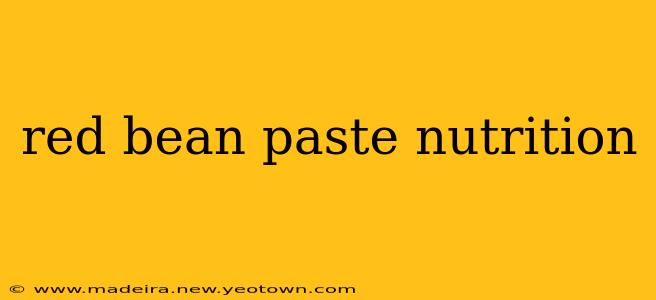Red bean paste, that sweet, subtly earthy filling found in mooncakes, buns, and countless other Asian desserts, is more than just a delicious treat. It’s a nutritional powerhouse packed with surprising health benefits. Let's unravel the secrets of this culinary gem, exploring its nutritional profile and answering some frequently asked questions.
What are the nutritional benefits of red bean paste?
Red bean paste, primarily made from adzuki beans ( Vigna angularis), boasts a remarkable nutrient profile. These small, vibrant beans are rich in fiber, protein, and various essential vitamins and minerals. Imagine this: a spoonful of sweetness that also contributes to your daily intake of essential nutrients! This makes it a surprisingly healthy choice compared to many other sweet spreads. Its fiber content aids digestion, while its protein provides sustained energy. Furthermore, the paste contains iron, potassium, and various antioxidants, all contributing to overall well-being.
Is red bean paste good for weight loss?
This is a question many are curious about. While red bean paste is undeniably delicious and offers several health benefits, it’s crucial to remember that it’s still a relatively high-calorie food due to its carbohydrate content. However, the high fiber content can contribute to satiety, meaning you may feel fuller for longer, potentially aiding in weight management. The key here is moderation. Incorporating red bean paste as part of a balanced diet, rather than consuming large quantities, is the path to success. Don't expect miracles, but it can certainly be part of a healthy weight management strategy.
How many calories are in red bean paste?
The calorie count in red bean paste varies depending on the brand and the amount of added sugar. Generally, a single tablespoon (approximately 15 grams) contains anywhere from 50 to 70 calories. However, it’s always best to check the specific nutritional information on the packaging of the product you're consuming.
What are the potential downsides of eating red bean paste?
While generally safe for consumption, excessive intake of red bean paste could lead to digestive issues for some individuals, especially those sensitive to legumes. The high sugar content in many commercially prepared pastes can also contribute to blood sugar spikes if consumed in large quantities. Therefore, moderation remains key. Always opt for brands with less added sugar to minimize potential negative effects.
Can I make red bean paste at home?
Absolutely! Making your own red bean paste allows for greater control over ingredients and sugar content. Numerous online recipes offer detailed instructions on how to prepare this delicious and nutritious paste from scratch. This is a great way to ensure you are consuming a healthier, less processed version of this beloved treat. It also allows for customization of sweetness to your liking.
Is red bean paste gluten-free?
Yes, naturally, red bean paste is gluten-free. However, always check the ingredients list of commercially produced pastes to ensure that no gluten-containing additives have been included during processing.
This exploration reveals that red bean paste is more than just a sweet ingredient in desserts. It’s a nutritional powerhouse that can be a part of a balanced and healthy diet. Remember, moderation and awareness of the ingredients are key to enjoying its many benefits. So, go ahead and savor that delicious mooncake – guilt-free (within reason, of course!).

